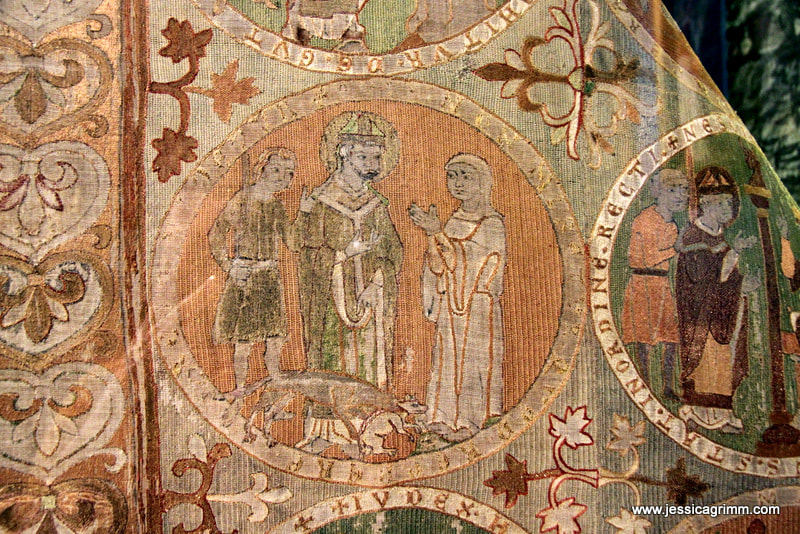|
Last year I made a trip to the Benedictine abbey of St. Paul im Lavanttal, Austria. The abbey houses two important medieval vestments. The friendly monk on duty was happy for me to take pictures without flash. Unfortunately, upon returning home, the first 30 or so pictures were lost during the transfer from my camera to my computer. Luckily, I am going to visit these beauties again in the next couple of days! And, as only the first pictures were lost, I can introduce you to the younger of the two pieces: a beautiful cope from the 13th century. Although these pieces are now housed in an abbey in Austria, they were originally made for the Benedictine abbey of St. Blaise in the Black Forest (Germany). During the dissolution of the monasteries in Bavaria in 1806, the abbot moved his convent and the treasure to St. Paul im Lavanttal and thus preserved them. Amongst the treasure were three medieval vestments: a cope from the 12th century (now in St. Paul), a cope from the 13th century (also in St. Paul) and a chasuble from the 13th century (now in the Österreichische Museum für angewandte Kunst in Vienna). The cope from the 13th century is stitched with silks and gold threads. The main stitches used on the cope are long-armed cross-stitch and brick stitch for the silk and couching for the gold threads. However, details are also worked in other surface stitches like chain stitch and split stitch. The silk used for the brick stitch is untwisted, but looks softly twisted and thicker for the long-armed cross-stitch. Originally, no linen background fabric showed; the whole cope was covered in stitches! During conservation, it became clear that the cope had been sown together from loom-width strips of linen before the stitching commenced. Depicted on the cope are the hagiographies (legends of the saints) of St. Blaise on the one side and St. Vincent of Saragossa on the other. Both saints were the patron saints of the abbey church. Scenes of the hagiographies are depicted as medallions as would have been the norm for stained glass windows in the 13th century. Each scene is accompanied by a few words to aid identification. There are two possibilities regarding the maker of this excellent piece of medieval embroidery in the 13th century. It is quite possible that the cope was stitched by the monks of the abbey of St. Blaise. But it is equally possible that this cope was stitched at a professional workshop. Either way, it is highly likely that the person who made this was a man rather than a woman. A fact I love to "share" with male visitors to the Pilatushaus who exclaim that my stitching is a "mere female past-time they are thus not interested in" :). Who provided the capital needed to produce these 'top-end' liturgical vestments? The St. Blaise abbey belonged to a reform movement in the Benedictine tradition. A movement highly endorsed by the nobility. Not only were many of the monks of noble birth, but noble families would endow the abbey with cash, lands, rights and works of art. These vestments were far costlier than the golden monstrance on the altar. Not only were the materials needed to stitch one quite costly, the countless man hours invested made the end-result VERY expensive. Another 'fun fact' for my visitors at the Pilatushaus who exclaim that the price tag on St. Laurence means the piece is unaffordable. I pleasantly inform them that in the Middle Ages they, as the commoners they are, would not have come this close to such a work of art :). Oh, you should see their faces! Truly priceless :). If you are ever in the area, do visit St. Paul! They have many embroidered liturgical vestments on display. Everything is quite well lit so that intricate details are visible. Essays on the art historical background of the pieces and the conservation of two of the three pieces can be found in: Braunsteiner, M. & H. Kaindl (1998): Historische Textilien aus dem Sakralbereich (=Schriften zur Kunst- und Kulturgeschichte des Benediktinerstiftes Admont, Band VII), ISBN 3-901810-02-1.
3 Comments
Thank you for sharing this beautiful piece with us! I’m always fascinated by these works (and I did have to laugh at this being the younger of the pieces from the 13th Century! Us Australians struggle with such concepts!). It’s incredible how the whole piece is covered in embroidery. Certainly very skilled workmanship to produce such a lovely piece. And I do love your comments you can make to visitors to your stand 😂
Reply
Marina Berts
17/8/2018 13:38:07
Thank you for sharing your pictures with us! Beautiful beautiful works of art, and so costly in those days, as they are still today. Imagine, textiles from the 12th century, that's fantastic. You always make me laugh when you tell us anecdotes of people (especially men) who speak negatively about embroidery and how you turn the situation around. Well done!
Reply
Your comment will be posted after it is approved.
Leave a Reply. |
Want to keep up with my embroidery adventures? Sign up for my weekly Newsletter to get notified of new blogs, courses and workshops!
Liked my blog? Please consider making a donation or becoming a Patron so that I can keep up the good work and my blog ad-free!
Categories
All
Archives
July 2024
|
Contact: info(at)jessicagrimm.com
Copyright Dr Jessica M. Grimm - Mandlweg 3, 82488 Ettal, Deutschland - +49(0)8822 2782219 (Monday, Tuesday, Friday & Saturday 9.00-17.00 CET)
Impressum - Legal Notice - Datenschutzerklärung - Privacy Policy - Webshop ABG - Widerrufsrecht - Disclaimer
Copyright Dr Jessica M. Grimm - Mandlweg 3, 82488 Ettal, Deutschland - +49(0)8822 2782219 (Monday, Tuesday, Friday & Saturday 9.00-17.00 CET)
Impressum - Legal Notice - Datenschutzerklärung - Privacy Policy - Webshop ABG - Widerrufsrecht - Disclaimer













 RSS Feed
RSS Feed